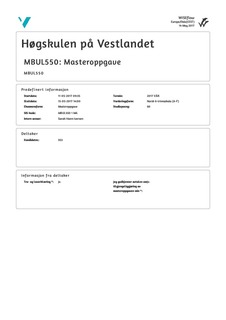| dc.contributor.author | Fjelltveit, Ina | |
| dc.date.accessioned | 2018-02-01T14:41:06Z | |
| dc.date.available | 2018-02-01T14:41:06Z | |
| dc.date.issued | 2017-05-15 | |
| dc.identifier.uri | http://hdl.handle.net/11250/2481418 | |
| dc.description | Master’s thesis in Children and Young Adults’ Literature | en_GB |
| dc.description.abstract | In this master’s thesis I compare the child audience’s experience of the characters Coraline and the other mother in an excerpt from Neil Gaiman’s book Coraline and in Henry Selick’s film Coraline and the secret door. My aim is to look at how the two media give children similar and different experiences of the two characters, and provide possible explanations for these similarities and differences. Twenty children participated in the research, ten of whom read the book excerpt and ten watched the film clip. The children were then interviewed individually. The thesis employs reader-response theory to explore the child audience’s experience of the characters in the book and the film. I investigate how the children filled the gaps in the two media. The Iserian term “gap” refers to those unwritten parts of the text where the readers are invited to participate in the meaning-making of the story. The thesis also studies how and where the children adopted aesthetic and efferent stances in the two media. Louise M. Rosenblatt’s terms refer to the readers’ ability to immerse themselves in the story during the reading event (aesthetic reading) and their ability to focus on acquiring information and logical solutions (efferent reading). In addition, my analysis relies on Maria Nikolajeva’s typology of character presentations as well as adaptation theory. I look at how books and films present characters differently, and how the children seem to be affected by this. The findings reveal both differences and similarities in how the children experience the characters. In general, the children who read the book excerpt read more aesthetically and filled more gaps in the text, while the children who watched the film clip watched more efferently and filled fewer gaps. These differences are due to medium-specific features, the children’s competence and expectations, as well as narrative choices that are not necessarily due to the given media. As the results reveal, film may give a better understanding of the narrative to children with limited literacy skills, while books may open up for more in-depth interpretations and gap-filling due to ambiguities that are not to be found to the same extent in films. | en_GB |
| dc.description.abstract | I denne masteroppgaven sammenligner jeg barns opplevelse av karakterene Coraline og den andre moren i et utdrag fra Neil Gaimans bok Coraline med Henry Selicks film Coraline og den hemmelige dør . Formålet mitt er å se hvordan de to mediene gir barn like og ulike opplevelser av karakterene, samt gi ulike forklaringer på disse likhetene og forskjellene. Tjue barn deltok i forskningen, der av ti leste bokutdraget og ti så filmklippet. Barna ble deretter intervjuet individuelt. Oppgaven benytter leserorientert teori for å utforske barnas opplevelse av karakterene i boken og filmen. Jeg undersøker hvordan barna har fylt tomrommene i de to mediene. Det Iserianske begrepet “tomrom” refererer til de uskrevne delene av teksten der leserne inviteres til å delta i meningsskapingen av historien. Oppgaven tar også for seg hvordan og hvor barna har tatt i bruk estetiske og efferente leserposisjoner i mediene. Louise M. Rosenblatts begreper refererer til lesernes evne til å leve seg inn i historien under selve lesestunden (estetisk lesning) og deres evne til å fokusere på å tilegne seg informasjon og logiske slutninger (efferent lesning). I tillegg støttes oppgaven av Maria Nikolajevas typologi av karakterfremstillinger, samt adaptasjonsteori. Jeg undersøker hvordan bøker og filmer fremstiller karakterer ulikt, og hvordan barna ser ut til å være påvirket av dette. Funnene avslører både forskjeller og likheter i hvordan barna opplever karakterene. Generelt sett leste barna som ble eksponert for utdraget mer estetisk og fylte flere tomrom i teksten, mens barna som ble eksponert for filmklippet så mer efferent og fylte færre tomrom. Disse forskjellene er grunnet mediespesifikke trekk, barnas kompetanse og forventninger, samt narrative valg som ikke nødvendigvis er grunnet mediet. Som resultatene viser kan film gi barn med begrensede leseferdigheter en bedre forståelse av fortellingen, mens bøker kan åpne opp for flere dyptgående tolkninger og fylling av tomrom grunnet uklarheter som ikke finnes i samme grad i film. | en_GB |
| dc.language.iso | eng | en_GB |
| dc.publisher | Høgskulen på Vestlandet/ Western Norway University of Applied Sciences | en_GB |
| dc.rights | Attribution-NonCommercial-ShareAlike 3.0 Norway | * |
| dc.rights.uri | http://creativecommons.org/licenses/by-nc-sa/3.0/no/ | * |
| dc.subject.other | Coraline | en_GB |
| dc.subject.other | media | en_GB |
| dc.subject.other | children`s experience | en_GB |
| dc.subject.other | book | en_GB |
| dc.subject.other | film | en_GB |
| dc.subject.other | medier | en_GB |
| dc.subject.other | barns opplevelse | en_GB |
| dc.subject.other | bok | en_GB |
| dc.title | Coraline and the other mother: different media, different experience? A comparative study of children’s experience of the characters in the book Coraline and the film Coraline and the secret door | en_GB |
| dc.title.alternative | Coraline og den andre moren: ulike medier, ulik opplevelse? En komparativ studie av barns opplevelse av karakterene i boken Coraline og filmen Coraline og den hemmelige dør | en_GB |
| dc.type | Master thesis | en_GB |

